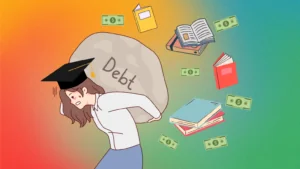As reported by Nicole Goodkind in CNN Business, the cost of attending some US colleges now surpasses $95,000 per year, raising concerns about affordability and accessibility. With American savings averaging $5,011 annually, it would take approximately 75 years to accumulate enough to send one child to a top-rated US university, let alone afford the rising costs.

✅ AI Essay Writer ✅ AI Detector ✅ Plagchecker ✅ Paraphraser
✅ Summarizer ✅ Citation Generator
Key Takeaways
- The average US private college tuition grew about 4% last year.
- Between 1980 and 2020, undergraduate degree costs rose by 169%, while wages for workers aged 22-27 only increased by 19%.
- Confidence in higher education has plummeted, with only 36% of Americans maintaining faith in the system, a drop of more than 20 percentage points from eight years prior.
The Rising Cost of Educating the Educators
One of the central factors contributing to the rapid increase in college tuition is the escalating cost of employing professors. Catharine Hill, an economist with the education nonprofit organization Ithaka S&R and the former president of Vassar College, provides valuable insight into this issue. Real wages for skilled workers such as professors and administrators have persistently outpaced inflation, resulting in increased expenditure on human resources by universities. This scenario starkly contrasts other industries, which have managed to compensate for rising labor costs with substantial productivity gains through the utilization of advanced technology like artificial intelligence and robotics. However, education remains an exception, heavily relying on the human touch that is irreplaceable by machines.
Competing for Wealthy Students: The Impact of Income Inequality
The aggravating issue of income inequality in the US further exacerbates the tuition problem. With an astonishing 70% of US wealth concentrated in the hands of the top 10% of Americans, a significant increase from about 61% in 1989, and the top 1% of earners pocketing 21% of all income, top universities have found themselves in a position to charge increasingly exorbitant fees. With such high stakes, wealthy families are often willing to pay these steep costs for the promise of small classes, well-equipped dormitories, and quality food. As a result of this trend, universities now find themselves splurging more on administrative services and luxuries than ever before in a bid to cater to the demands of these affluent families.
Public Funding Dwindles
The decreasing contributions from state legislatures toward public education budgets are added to the burden. Between 2020 and 2021, state funding for higher education declined by an average of 6% across 37 states. This scenario has forced colleges and universities to rely more on student payments, thus amplifying the amount of student debt. The reduced public funding not only exacerbates the student burden but also raises questions about the feasibility and accessibility of higher education in a democratic society that prides itself on equal opportunity.
The Net Price of College and Financial Aid
Interestingly, although the sticker prices of colleges are reaching new heights, the net cost — the amount that students and their families end up actually paying — has shown a declining trend, largely due to the intervention of financial aid and other subsidies. When adjusted for inflation, the actual price paid for private colleges has dropped by 11% over the past five years, while the cost for public colleges has seen a reduction of 13%. However, it’s essential to remember that these statistics do not provide a complete picture, as not everyone benefits from financial aid, and those who do not are left grappling with the soaring costs.
The Future and the Student Debt Explosion
Despite the decrease in net price, the specter of student loan debt looms large. The average student loan debt has shot up by an astounding 2807% since 1970 before adjusting for inflation, according to the Education Data Initiative. A recent Supreme Court ruling blocking President Biden’s student loan forgiveness program has added to the woes, leaving the burden of the $1.6 trillion in outstanding student loan debt heavily weighing on American students.
Conclusion
The current trajectory of rising tuition costs, coupled with stagnant wage growth and an expanding wealth gap, brings into sharp focus the sustainability of the American higher education model. While the net price of a college may be on the decline, this small silver lining does little to mitigate the overarching problem of a ballooning student debt crisis. Without significant systemic changes, the cost of a college education seems set to continue its upward climb, further exacerbating wealth inequalities and posing a grave threat to opportunities for future generations.
Follow us on Reddit for more insights and updates.





Comments (0)
Welcome to A*Help comments!
We’re all about debate and discussion at A*Help.
We value the diverse opinions of users, so you may find points of view that you don’t agree with. And that’s cool. However, there are certain things we’re not OK with: attempts to manipulate our data in any way, for example, or the posting of discriminative, offensive, hateful, or disparaging material.